engine Alfa Romeo Giulietta 2012 Owner handbook (in English)
[x] Cancel search | Manufacturer: ALFA ROMEO, Model Year: 2012, Model line: Giulietta, Model: Alfa Romeo Giulietta 2012Pages: 297, PDF Size: 9.37 MB
Page 156 of 297

152
GETTING
TO KNOW
YOUR CAR
SAFETY
STARTING
AND DRIVING
IN AN
EMERGENCY
SERVICING AND
MAINTENANCE
TECHNICAL
SPECIFICATIONS
CONTENTS
It is advisable not to demand maximum perfor-
mance from your car (e.g. excessive acceleration,
long distances at top rpm, excessively intense brak-
ing, etc.) when it is first used.
Remember that the brake servo and electro-
mechanical power steering are not operational un-
til the engine has been started, therefore much
more effort than usual is required on the brake pedal and
steering wheel.
Never jump start the engine by pushing, towing or
driving downhill. These manoeuvres may damage
the catalytic converter.
When the engine is switched off never leave the
key in the MAR position to prevent useless cur-
rent absorption from draining the battery.
HOW TO WARM UP THE ENGINE
AFTER IT HAS JUST STARTED
Proceed as follows:
❍drive off slowly, letting the engine turn at medium speed. Do
not accelerate abruptly;
❍do not demand maximum performance for the first few kilo-
metres. Wait until the engine coolant temperature indicator
starts moving.
STOPPING THE ENGINE
Turn the ignition key to STOP while the engine is idling.
IMPORTANT After a taxing drive, before turning the engine off you
should allow it to idle to allow the temperature in the engine com-
partment to fall.
A quick burst on the accelerator before turning off
the engine serves absolutely no practical purpose;
it wastes fuel and is especially damaging to tur-
bocharged engines.
Page 157 of 297

153
GETTING
TO KNOW
YOUR CAR
SAFETY
STARTING
AND DRIVING
IN AN
EMERGENCY
SERVICING AND
MAINTENANCE
TECHNICAL
SPECIFICATIONS
CONTENTS
IMPORTANT Carry out these manoeuvres with the brake pedal pressed.
IMPORTANT For cars equipped with a front armrest, lift this up to
ensure that it does not interfere with the action of the handbrake.
fig. 110A0K0073m
The car should be locked after a few notches: if this
is not so, contact Alfa Romeo Authorized Services to
have the handbrake adjusted.
PARKING THE CAR
Switch off the engine and pull up the handbrake. Engage a gear
(1stif the car is facing uphill or reverse if it is facing downhill) and
leave the wheels steered to one side.
If the car is parked on a steep slope block the wheels with a wedge
or stone. Always remove the ignition key when leaving the car.
HANDBRAKE fig. 110
To engage the handbrake pull lever A upwards until the car is se-
cured. To disengage slightly raise lever A, press and hold down but-
ton B and lower the lever.
Page 160 of 297
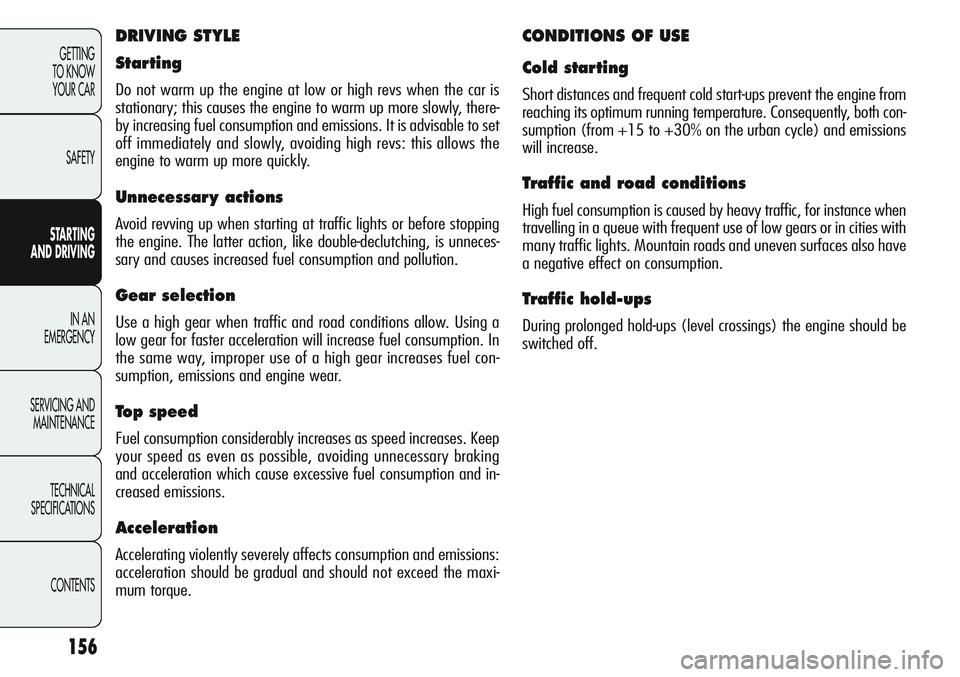
156
GETTING
TO KNOW
YOUR CAR
SAFETY
STARTING
AND DRIVING
IN AN
EMERGENCY
SERVICING AND
MAINTENANCE
TECHNICAL
SPECIFICATIONS
CONTENTS
DRIVING STYLE
Starting
Do not warm up the engine at low or high revs when the car is
stationary; this causes the engine to warm up more slowly, there-
by increasing fuel consumption and emissions. It is advisable to set
off immediately and slowly, avoiding high revs: this allows the
engine to warm up more quickly.
Unnecessar y actions
Avoid revving up when starting at traffic lights or before stopping
the engine. The latter action, like double-declutching, is unneces-
sary and causes increased fuel consumption and pollution.
Gear selection
Use a high gear when traffic and road conditions allow. Using a
low gear for faster acceleration will increase fuel consumption. In
the same way, improper use of a high gear increases fuel con-
sumption, emissions and engine wear.
Top speed
Fuel consumption considerably increases as speed increases. Keep
your speed as even as possible, avoiding unnecessary braking
and acceleration which cause excessive fuel consumption and in-
creased emissions.
Acceleration
Accelerating violently severely affects consumption and emissions:
acceleration should be gradual and should not exceed the maxi-
mum torque.
CONDITIONS OF USE
Cold starting
Short distances and frequent cold start-ups prevent the engine from
reaching its optimum running temperature. Consequently, both con-
sumption (from +15 to +30% on the urban cycle) and emissions
will increase.
Traffic and road conditions
High fuel consumption is caused by heavy traffic, for instance when
travelling in a queue with frequent use of low gears or in cities with
many traffic lights. Mountain roads and uneven surfaces also have
a negative effect on consumption.
Traffic hold-ups
During prolonged hold-ups (level crossings) the engine should be
switched off.
Page 163 of 297
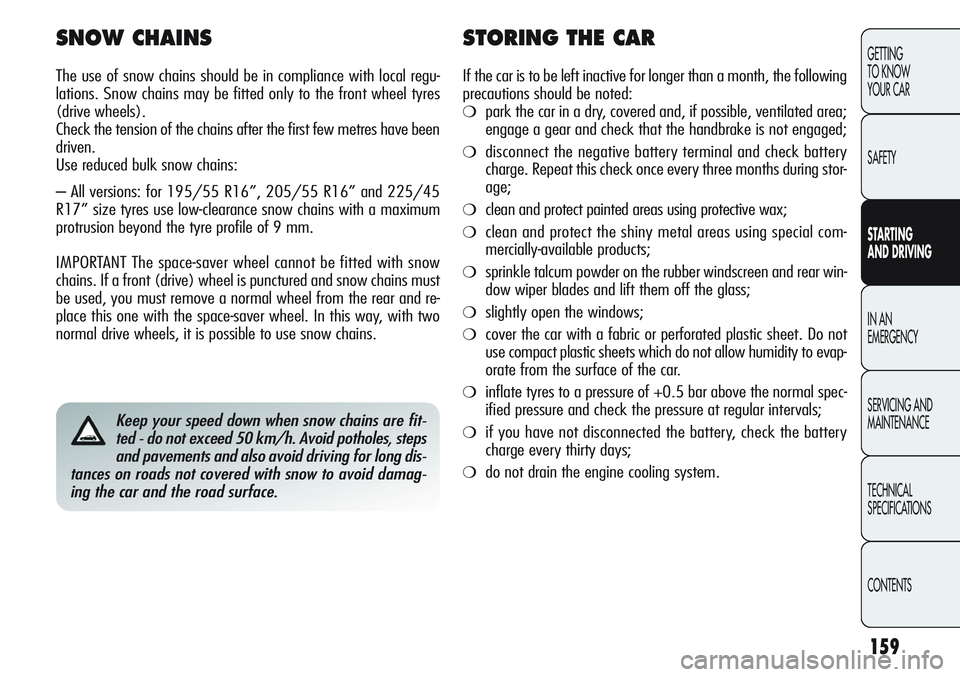
159
GETTING
TO KNOW
YOUR CAR
SAFETY
STARTING
AND DRIVING
IN AN
EMERGENCY
SERVICING AND
MAINTENANCE
TECHNICAL
SPECIFICATIONS
CONTENTS
Keep your speed down when snow chains are fit-
ted - do not exceed 50 km/h. Avoid potholes, steps
and pavements and also avoid driving for long dis-
tances on roads not covered with snow to avoid damag-
ing the car and the road surface.
SNOW CHAINS
The use of snow chains should be in compliance with local regu-
lations. Snow chains may be fitted only to the front wheel tyres
(drive wheels).
Check the tension of the chains after the first few metres have been
driven.
Use reduced bulk snow chains:
– All versions: for 195/55 R16”, 205/55 R16” and 225/45
R17” size tyres use low-clearance snow chains with a maximum
protrusion beyond the tyre profile of 9 mm.
IMPORTANT The space-saver wheel cannot be fitted with snow
chains. If a front (drive) wheel is punctured and snow chains must
be used, you must remove a normal wheel from the rear and re-
place this one with the space-saver wheel. In this way, with two
normal drive wheels, it is possible to use snow chains.
STORING THE CAR
If the car is to be left inactive for longer than a month, the following
precautions should be noted:
❍park the car in a dry, covered and, if possible, ventilated area;
engage a gear and check that the handbrake is not engaged;
❍disconnect the negative battery terminal and check battery
charge. Repeat this check once every three months during stor-
age;
❍clean and protect painted areas using protective wax;
❍clean and protect the shiny metal areas using special com-
mercially-available products;
❍sprinkle talcum powder on the rubber windscreen and rear win-
dow wiper blades and lift them off the glass;
❍slightly open the windows;
❍cover the car with a fabric or perforated plastic sheet. Do not
use compact plastic sheets which do not allow humidity to evap-
orate from the surface of the car.
❍inflate tyres to a pressure of +0.5 bar above the normal spec-
ified pressure and check the pressure at regular intervals;
❍if you have not disconnected the battery, check the battery
charge every thirty days;
❍do not drain the engine cooling system.
Page 165 of 297
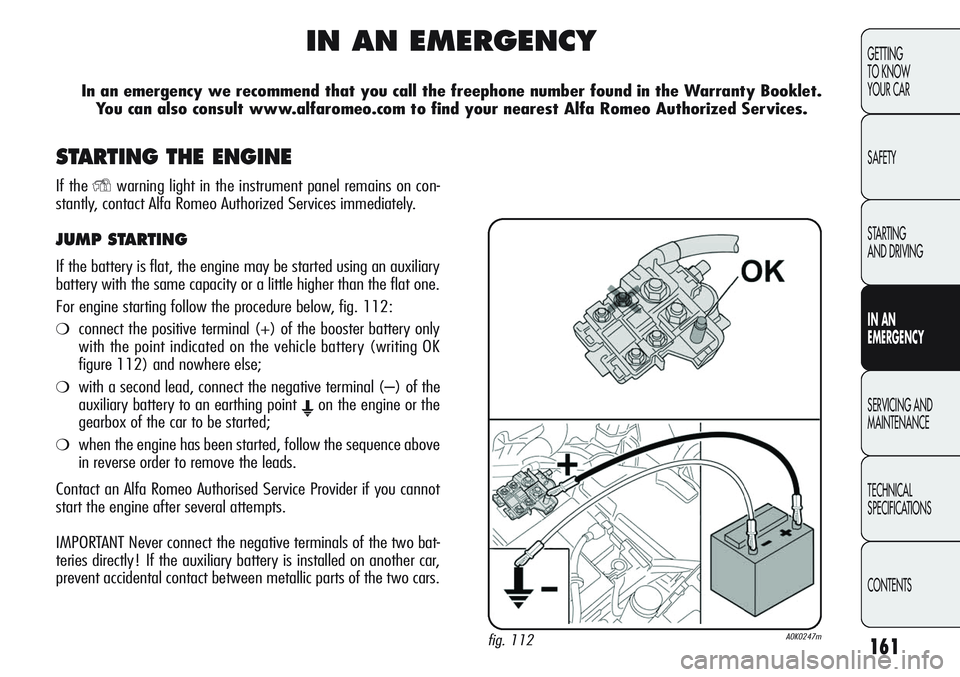
161
GETTING
TO KNOW
YOUR CAR
SAFETY
STARTING
AND DRIVING
IN AN
EMERGENCY
SERVICING AND
MAINTENANCE
TECHNICAL
SPECIFICATIONS
CONTENTS
IN AN EMERGENCY
In an emergency we recommend that you call the freephone number found in the Warranty Booklet.
You can also consult www.alfaromeo.com to find your nearest Alfa Romeo Authorized Services.
STARTING THE ENGINE
If the Ywarning light in the instrument panel remains on con-
stantly, contact Alfa Romeo Authorized Services immediately.
JUMP STARTING
If the battery is flat, the engine may be started using an auxiliary
battery with the same capacity or a little higher than the flat one.
For engine starting follow the procedure below, fig. 112:
❍connect the positive terminal (+) of the booster battery only
with the point indicated on the vehicle battery (writing OK
figure 112) and nowhere else;
❍with a second lead, connect the negative terminal (–) of the
auxiliary battery to an earthing point
Eon the engine or the
gearbox of the car to be started;
❍when the engine has been started, follow the sequence above
in reverse order to remove the leads.
Contact an Alfa Romeo Authorised Service Provider if you cannot
start the engine after several attempts.
IMPORTANT Never connect the negative terminals of the two bat-
teries directly! If the auxiliary battery is installed on another car,
prevent accidental contact between metallic parts of the two cars.
fig. 112A0K0247m
Page 166 of 297

162
GETTING
TO KNOW
YOUR CAR
SAFETY
STARTING
AND DRIVING
IN AN
EMERGENCY
SERVICING AND
MAINTENANCE
TECHNICAL
SPECIFICATIONS
CONTENTS
The space-saver spare wheel is vehicle-specific:
do not use it on vehicles of other model and do not
use space-saver spare wheels from other models
on your car. The space-saver spare wheel must only be
used in an emergency. Never use it longer than strictly
necessary and never exceed 80 km/h. On the space-saver
spare wheel there is a label, summarizing the main warn-
ings about the space-saver spare wheel usage restrictions.
Never remove or cover the label. Never apply any hub
cap to the space-saver spare wheel.
CHANGING A TYRE
GENERAL INSTRUCTIONS
The car is equipped with an “Automatic Fix&Go Kit“: see “Auto-
matic Fix&Go Kit” for how to use this device.
Alternatively to the “Automatic Fix&Go Kit” the car may be
equipped with a space-saver spare wheel: see the instructions on
the following pages for changing the tyre.
Use your hazard lights, warning triangle, etc. to
show that your car is stationary in compliance with
regulations. Passengers should get out of the car,
particularly if it is heavily loaded, and wait for the wheel
to be changed away from the traffic. In the event of a
wheel change on a slope or on unsurfaced roads, chock
the wheels.
BUMP STARTING
Never start the engine by pushing, towing or driving downhill.
Never use a fast battery-charger to start the en-
gine as this could damage the electronic systems
of your car, particularly the ignition and fuel sup-
ply control units.
Page 168 of 297
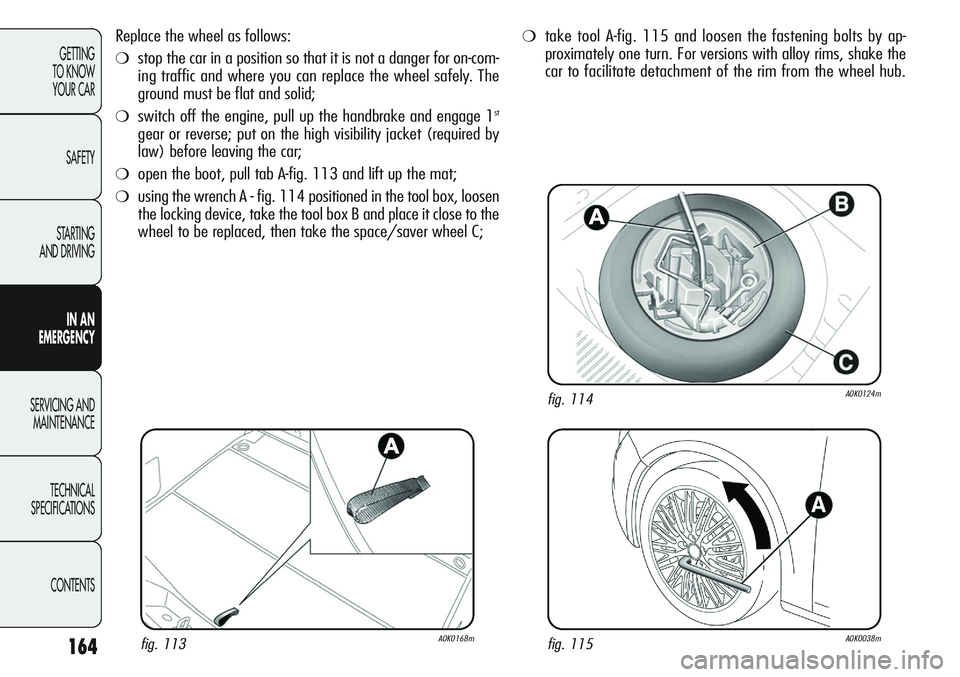
164
GETTING
TO KNOW
YOUR CAR
SAFETY
STARTING
AND DRIVING
IN AN
EMERGENCY
SERVICING AND
MAINTENANCE
TECHNICAL
SPECIFICATIONS
CONTENTS
Replace the wheel as follows:
❍stop the car in a position so that it is not a danger for on-com-
ing traffic and where you can replace the wheel safely. The
ground must be flat and solid;
❍switch off the engine, pull up the handbrake and engage 1st
gear or reverse; put on the high visibility jacket (required by
law) before leaving the car;
❍open the boot, pull tab A-fig. 113 and lift up the mat;
❍using the wrench A - fig. 114 positioned in the tool box, loosen
the locking device, take the tool box B and place it close to the
wheel to be replaced, then take the space/saver wheel C;
fig. 115A0K0038m
❍take tool A-fig. 115 and loosen the fastening bolts by ap-
proximately one turn. For versions with alloy rims, shake the
car to facilitate detachment of the rim from the wheel hub.
fig. 114A0K0124m
fig. 113A0K0168m
Page 175 of 297

171
GETTING
TO KNOW
YOUR CAR
SAFETY
STARTING
AND DRIVING
IN AN
EMERGENCY
SERVICING AND
MAINTENANCE
TECHNICAL
SPECIFICATIONS
CONTENTS
INFLATION PROCEDURE
Wear the gloves included in the kit.
Proceed as follows:
❍apply the handbrake, loosen the cap from the tyre inflation
valve, extract the flexible tube A-fig. 125 and screw ring nut
B onto the tyre inflation valve;
❍make sure that switch A-fig. 126 for the compressor is in po-
sition 0 (off), start the engine, insert the plug into the luggage
compartment current socket (see fig. 126a) or cigar lighter on
central tunnel (see fig. 127) and switch on the compressor
by bringing switch A-fig. 126 to position I (on);
fig. 125A0K0127mfig. 126aA0K0152m
fig. 126A0K0021m
Page 176 of 297
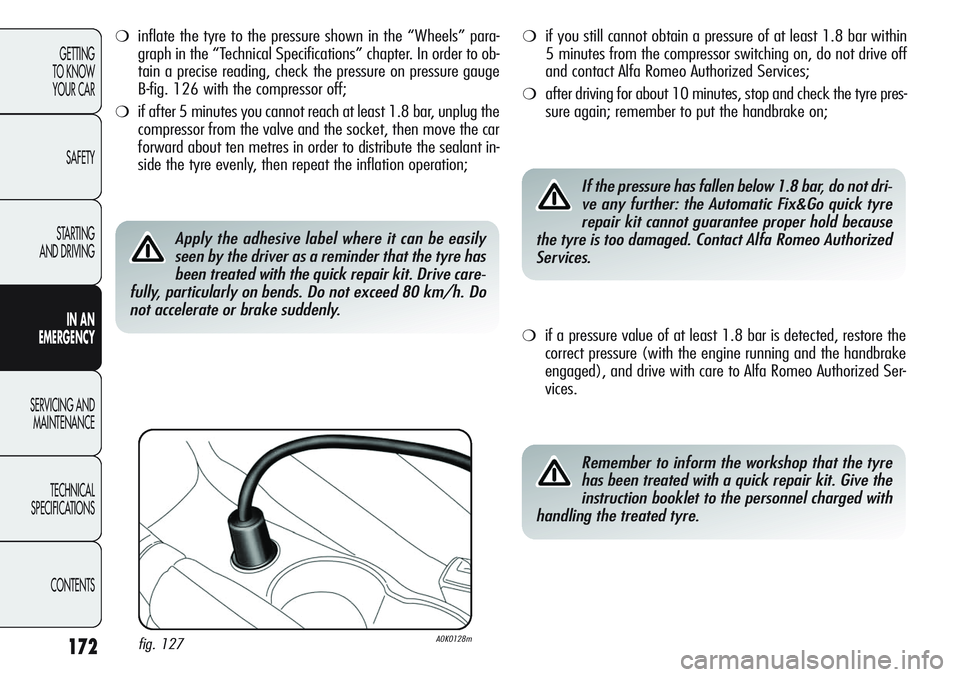
172
GETTING
TO KNOW
YOUR CAR
SAFETY
STARTING
AND DRIVING
IN AN
EMERGENCY
SERVICING AND
MAINTENANCE
TECHNICAL
SPECIFICATIONS
CONTENTS
❍inflate the tyre to the pressure shown in the “Wheels” para-
graph in the “Technical Specifications” chapter. In order to ob-
tain a precise reading, check the pressure on pressure gauge
B-fig. 126 with the compressor off;
❍if after 5 minutes you cannot reach at least 1.8 bar, unplug the
compressor from the valve and the socket, then move the car
forward about ten metres in order to distribute the sealant in-
side the tyre evenly, then repeat the inflation operation;
❍if you still cannot obtain a pressure of at least 1.8 bar within
5 minutes from the compressor switching on, do not drive off
and contact Alfa Romeo Authorized Services;
❍after driving for about 10 minutes, stop and check the tyre pres-
sure again; remember to put the handbrake on;
Apply the adhesive label where it can be easily
seen by the driver as a reminder that the tyre has
been treated with the quick repair kit. Drive care-
fully, particularly on bends. Do not exceed 80 km/h. Do
not accelerate or brake suddenly.
❍if a pressure value of at least 1.8 bar is detected, restore the
correct pressure (with the engine running and the handbrake
engaged), and drive with care to Alfa Romeo Authorized Ser-
vices.
If the pressure has fallen below 1.8 bar, do not dri-
ve any further: the Automatic Fix&Go quick tyre
repair kit cannot guarantee proper hold because
the tyre is too damaged. Contact Alfa Romeo Authorized
Services.
Remember to inform the workshop that the tyre
has been treated with a quick repair kit. Give the
instruction booklet to the personnel charged with
handling the treated tyre.
fig. 127A0K0128m
Page 190 of 297
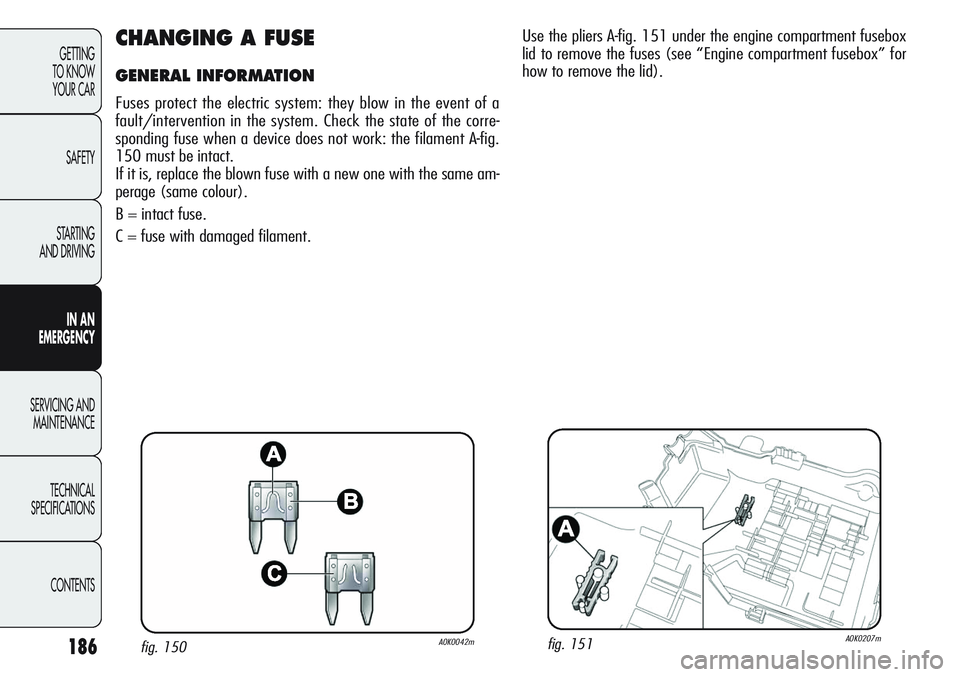
186
GETTING
TO KNOW
YOUR CAR
SAFETY
STARTING
AND DRIVING
IN AN
EMERGENCY
SERVICING AND
MAINTENANCE
TECHNICAL
SPECIFICATIONS
CONTENTS
CHANGING A FUSE
GENERAL INFORMATION
Fuses protect the electric system: they blow in the event of a
fault/intervention in the system. Check the state of the corre-
sponding fuse when a device does not work: the filament A-fig.
150 must be intact.
If it is, replace the blown fuse with a new one with the same am-
perage (same colour).
B = intact fuse.
C = fuse with damaged filament.
fig. 150A0K0042mfig. 151A0K0207m
Use the pliers A-fig. 151 under the engine compartment fusebox
lid to remove the fuses (see “Engine compartment fusebox” for
how to remove the lid).